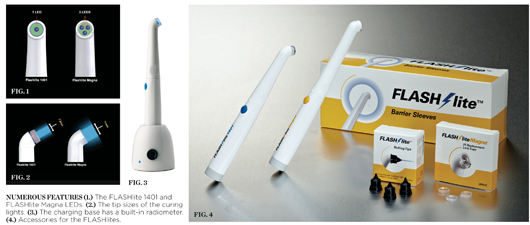FLASHlites’ Ideal Design
New curing lights fulfill dentists’ wish list of optimal features.
The advent of light-activated activators, such as camphorquinone, to cure light-cured resins ushered in an era in dentistry of conservative esthetic restorations, but introduced the challenge of delivering the light conveniently and predictably. The past 10 years has seen halogen lights that suffered from the slow degradation of the bulb requiring constant monitoring to avoid incompletely cured resin, which would ultimately cause sensitivity and a failed restoration. The argon laser was very quick, but with a very narrow wavelength; not all materials would cure and it was very expensive to maintain. Plasma arc lights entered as another high-powered light that offered a quick cure and there are many of these still sold today, but they are often very large units, which does not render them as very mobile.
Today, for most dentists an LED-type curing light is the most used and used daily. As such an essential part of the daily armamentarium, what features should dentists look for when considering the purchase of a curing light?
Cordless offers better ergonomics from not being bound to a cord, which lessens the risk of developing repetitive motion musculoskeletal disorders that has ended many careers. Cordless also offers mobility, as it can move from operatory to operatory, which could mean a cost savings from not having to purchase as many units. The battery would have to be dependable so it would not have to be charging all the time or run out during a critical time of a procedure. It should also be simple to use, and perhaps work with the push of a button. The power should be sufficient to give dentists a dependable depth of cure to avoid postoperative discomfort and restoration failure. And, finally, this ideal light should be affordable.
Discus Dental has two lights that represent the solutions in their FLASHlite 1401 and FLASHlite Magna (Figure 1). These two lights are small, compact, ergonomic, and powerful. They are powered by lithium-ion batteries, which make them cordless for both ideal ergonomics and mobility. Many doctors and hygienists take them from operatory to operatory. Typically these batteries will get dentists through a whole day.
Simple in operation, they have just a single button to activate. The FLASHlite 1401 beeps every 10 seconds; when the step is complete, hitting the button again will turn it off. The FLASHlite Magna beeps every 5 seconds and shuts off automatically after 20.
The FLASHlite 1401 has a single LED light and a 7.2-mm tip, while the FLASHlite Magna has three LEDs and a 11-mm tip (Figure 2); they have an average power density of 1,100 mW/cm2 and 1,500 mW/cm2, respectively. This gives both lights more than adequate curing power for more predictable restorations. Both lights have small inductive charging bases with built-in radiometers (Figure 3) to check the power output of these lights.
To round out the utility of these lights, there are slide-on light shields, removable single-use tacking tips, disposable barrier sleeves, and replacement lens caps for the FLASHlite Magna (Figure 4).
Some tips for curing success:
- Be sure the curing light lens is clear of any debris that could lower the output of the light.
- Avoid touching the tip of the light against the hard or soft tissue when activated due to the heat that could be generated by the light.
- Avoid holding the light tip too far from the material to be cured, as this will decrease the intensity of the light energy.
- Always cure for the times recommended by the manufacturers of the light-cured materials being used.
These two FLASHlites, 1401 and Magna, deliver more than the original list of ideal features. They are great award-winning lights that bring the ideal balance of size, power, and affordability together.
For More Information, contact:
Discus Dental
Phone: 800-422-9448
Web: www.discusdental.com
Disclaimer
The preceding material was provided by the manufacturer. The statements and opinions contained therein are solely those of the manufacturer and not of the editors, publisher, or the Editorial Board of Inside Dentistry.







